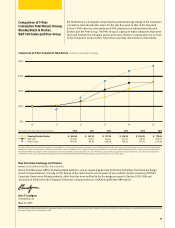Black & Decker 2015 Annual Report Download - page 19
Download and view the complete annual report
Please find page 19 of the 2015 Black & Decker annual report below. You can navigate through the pages in the report by either clicking on the pages listed below, or by using the keyword search tool below to find specific information within the annual report.
5
Other Information
Competition
The Company competes on the basis of its reputation for product quality, its well-known brands, its commitment to customer
service, strong customer relationships, the breadth of its product lines and its innovative products and customer value
propositions.
The Company encounters active competition in the Tools & Storage and Industrial segments from both larger and smaller
companies that offer the same or similar products and services. Certain large customers offer private label brands (“house
brands”) that compete across a wider spectrum of the Company’s Tools & Storage segment product offerings. Competition in
the Security segment is generally fragmented via both large international players and regional companies. Competition tends to
be based primarily on price, the quality of service and comprehensiveness of the services offered to the customers.
Major Customers
A significant portion of the Company’s Tools & Storage products are sold to home centers and mass merchants in the U.S. and
Europe. A consolidation of retailers both in North America and abroad has occurred over time. While this consolidation and the
domestic and international expansion of these large retailers has provided the Company with opportunities for growth, the
increasing size and importance of individual customers creates a certain degree of exposure to potential sales volume loss. As a
result of the Company’s acquisition strategy, sales to U.S. home centers and mass merchants declined from a high of
approximately 40% in 2002, to 15% before the Black & Decker merger. In 2015, sales to U.S. home centers and mass
merchants were 21%.
Working Capital
The Company continues to practice the core operating disciplines encompassed by the Stanley Fulfillment System (“SFS”).
SFS has five core principles that work in concert: sales and operations planning, operational lean, complexity reduction, global
supply management, and order-to-cash excellence. The Company develops standardized business processes and system
platforms to reduce costs and provide scalability. SFS is instrumental in the reduction of working capital evidenced by the 56%
improvement in working capital turns for the Company from 5.9 at the end of 2010 (excluding HHI) to 9.2 at the end of 2015.
The continued efforts to deploy SFS across the entire Company and increase turns have created significant opportunities to
generate incremental free cash flow. Going forward, the Company plans to further leverage the core SFS principles to generate
ongoing improvements, both in the existing business and future acquisitions, in working capital turns, cycle times, complexity
reduction and customer service levels, with a goal of ultimately achieving 10 working capital turns.
Raw Materials
The Company’s products are manufactured using ferrous and non-ferrous metals including, but not limited to steel, zinc,
copper, brass, aluminum and nickel as well as resins. The Company also purchases components such as batteries, motors, and
electronic components to use in manufacturing and assembly operations along with resin-based molded parts. The raw
materials required are procured globally and available from multiple sources at competitive prices. As part of the Company's
Enterprise Risk Management, the Company has implemented a supplier risk mitigation strategy in order to identify and address
any potential supply disruption associated with commodities, components, finished goods and critical services. The Company
does not anticipate difficulties in obtaining supplies for any raw materials or energy used in its production processes.
Backlog
Due to short order cycles and rapid inventory turnover primarily in the Company's Tools & Storage segment, backlog is
generally not considered a significant indicator of future performance. At February 6, 2016, the Company had approximately
$783 million in unfilled orders, which mainly relate to the Engineered Fastening and Security businesses. Substantially all of
these orders are reasonably expected to be filled within the current fiscal year. As of January 31, 2015 and February 1, 2014,
unfilled orders amounted to $888 million and $948 million, respectively.
Patents and Trademarks
No business segment is solely dependent, to any significant degree, on patents, licenses, franchises or concessions, and the loss
of one or several of these patents, licenses, franchises or concessions would not have a material adverse effect on any of the
businesses. The Company owns numerous patents, none of which individually is material to the Company's operations as a
whole. These patents expire at various times over the next 20 years. The Company holds licenses, franchises and concessions,
none of which individually or in the aggregate are material to the Company's operations as a whole. These licenses, franchises
and concessions vary in duration, but generally run from one to 40 years.
























